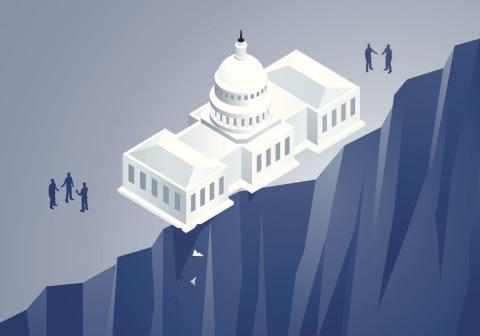https://www.youtube.com/watch?v=ZfjWIpnfjgQ
As voters, we’ll be asked to ignore the dereliction of duty demonstrated by our elected leaders; threatened with horrible outcomes if a federal budget isn’t passed and the debt ceiling isn’t increased; then, suffer through the traditional blame game, where the two major parties take turns distorting the truth and casting aspersions at each other in an attempt to gain a political advantage in next year’s midterm elections.
As I’ve said in the past, perhaps it’s time that we replaced the fiscal cliff with a political one.
Here are the facts of what Washington has on its plate:
- The federal fiscal year begins on October 1.
- The president is supposed to submit a detailed budget request by the first Monday in February (although new administrations are usually given a grace period).
- Congress is supposed to hold hearings on the administration’s budget before crafting its own “budget resolution,” which is a “concurrent” resolution rather than an ordinary bill. The budget resolution is generally less detailed than the president’s budget, only requiring a majority vote. It cannot be filibustered, nor vetoed by the president because it does not require the president’s signature. It is also supposed to be passed by April 15.
- Once the budget resolution is adopted, Congress is supposed to consider annual appropriation bills to fund discretionary programs in the next fiscal year and to enact legislative changes to mandatory spending or revenue levels (if directed to do so by the budget resolution).
There is also a budget reconciliation process. However, it has been largely ignored or abused for several decades. This year will be no exception.
In addition, government agencies are in the process of spending every penny possible before the October 1 deadline.
About one-third of our nation’s annual budget is spent in the fourth fiscal quarter because it’s a “use it or lose it” environment.
As a result, not only do our elected officials budget poorly (if at all) at the federal level, the system encourages a spendthrift approach to the utilization of funds.
Our national debt currently exceeds $20 trillion. That is an optimistic figure because our total unfunded liabilities exceed $107 trillion (or about 80 percent of the cumulative assets of our entire country).
In any event, brace yourself for acrimonious rhetoric, ongoing threats, and a complete evasion of responsibility by the parties that control our federal government.
For those who would like to see how history is simply repeating itself, here are links to three articles I wrote on July 12 and 20 of 2011 and on December 20, 2012: Debt ceiling negotiations: Pelosi, Boehner, Obama & Reid Liar’s Poker, The debt ceiling war: Cut, Cap, Balance vs. Cut, Tax, Spend, and Replace the fiscal cliff with a political one.
We have a new president, and the position of the parties has changed slightly as have some of the names of our congressional leaders.
Of course, they will introduce different issues into the current dilemma in an attempt to gain political leverage and distract us from their failings. No standards of decency will be left unturned because the exercise has become more about the 2018 election cycle than about the 2017 fiscal budget.
Perhaps it’s once again time to forget the fiscal cliff about which we’re conditioned to worry and, instead, shift the burden to our elected officials by pushing them toward a political cliff in 2018.
